List of Contents
What is the High Voltage Battery Market Size?
The global high voltage battery market size is calculated at USD 38.60 billion in 2025 and is predicted to increase from USD 50.00 billion in 2026 to approximately USD 523.90 billion by 2034, expanding at a CAGR of 33.60% from 2025 to 2034.
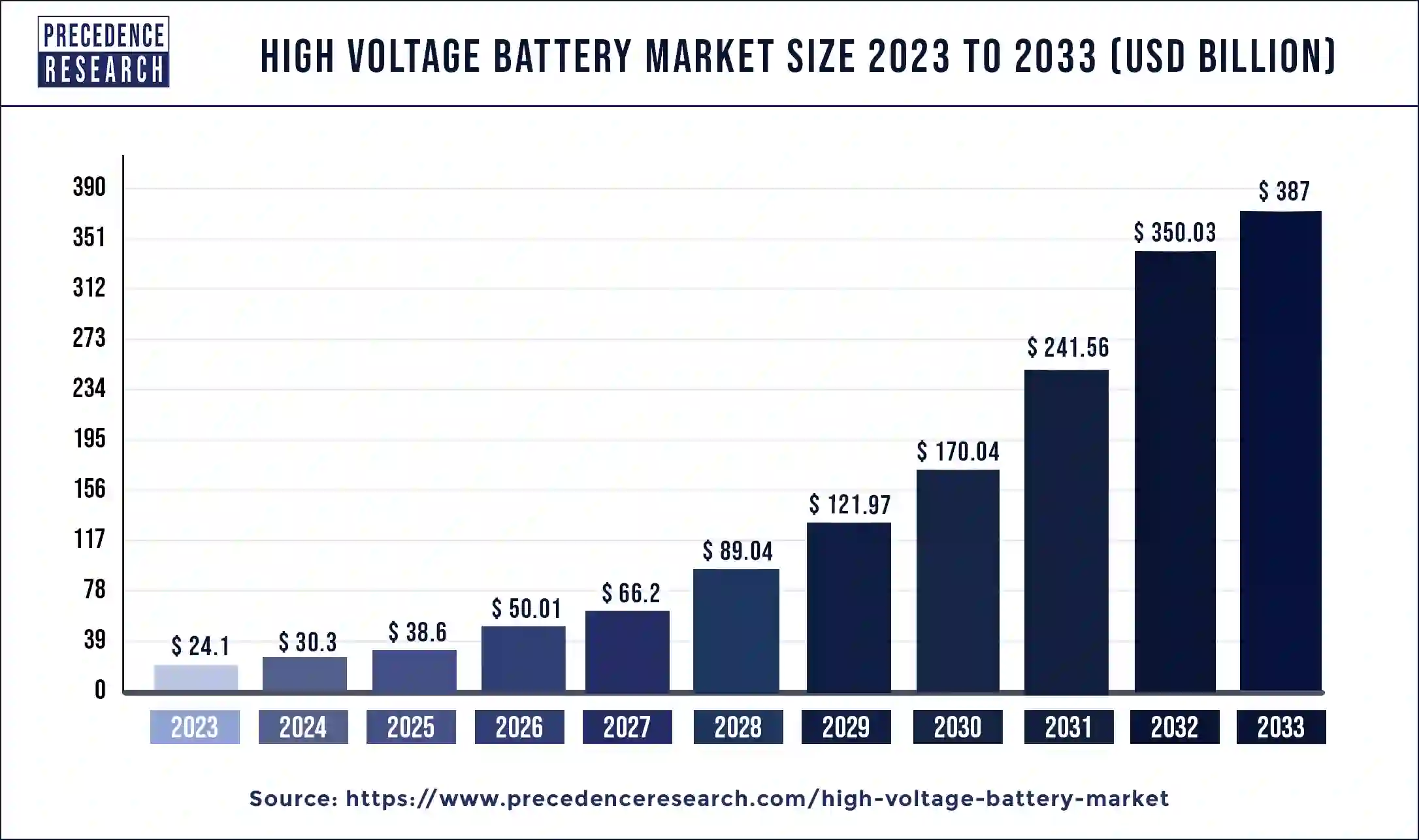
Key Takeaways
- In terms of revenue, the global high voltage battery market was valued at USD 30.30 billion in 2024.
- It is projected to reach USD 523.90 billion by 2034.
- The market is expected to grow at a CAGR of 33.60% from 2025 to 2034.
- Asia Pacific dominated the global market with the largest market share of 54.69% in 2024.
- By Battery Capacity, the 75 kWh–150 kWh segment captured the biggest market share of 47.25% in 2024.
- By Battery Type, the lithium nickel manganese cobalt oxide segment contributed the highest market share of 32.60% in 2024.
- By Driving Range, 401–550 miles segment generated the major market share of 34.32% in 2024.
The Silent Dynamo Behind Electrified Mobility & Grid Resilience
The high voltage battery is the type battery that allows for higher-than-normal voltage. It has higher energy density than standard lithium–ion polymer batteries. High Voltage battery system are rated around 400V and are able to get charged and discharged faster than low voltage batteries. They do not need large conductors as their voltage is too high. The lithium high voltage battery is more energy intensive as compared to traditional LiPo batteries. They are made up of Lithium cobalt oxide, lithium iron phosphate, lithium manganese oxide, lithium nickel manganese cobalt oxide (NMC).
The high voltage lithium polymer batteries having the nominal voltage over 3.7 V are having the ability to retain more power as compared to ordinary batteries. They are quickly chargeable and provide high output. These batteries have high application in hybrid and electric industries like boat motors, drones etc. They are quite expensive and have complications regarding the recycling of batteries, due to the presence of toxic and hazardous metal content requiring extra attention. The enhanced technology of high voltage batteries and matured safety ratings will help the particular market to grow in the upcoming years.
High-voltage batteries are the energy-dense, high-power cells and packs that drive electric vehicles, industrial electrification, and utility-scale energy storage. Once a niche engineering solution, they now sit at the core of the transition from fossil fuels to electrified transport and flexible grids. The market spans cell chemistries, lithium-ion variants and emerging alternatives, module and pack engineering, battery management systems BMS, thermal management, and recycling infrastructures. Demand is shaped by EV adoption, renewable integration, industrial electrification, and regulatory pressure to lower carbon intensity across transport and power sectors.
Growth Factors
The increasing demand of high driving range vehicles, smart transportation and the advancement in batteries chemistry are the factors which are expected to play an important role in the growth of high voltage market. The battery capacity of > 300 kWh batteries is expected to be the reason for it being the largest contributor in the high voltage battery market. The growth of these type of batteries are generally driven by the dominance of electric bus industry in country like China. The electrification of public transport is driving the demand of electric buses and trucks which eventually has pushed the demand of high voltage batteries in the market.
The primary insights of various reports shows that Tesla semi's battery pack will have the capacity of 800-1000 kWh, so it will be a game changer in the the industry of electric truck, as the majority of Tesla semi-trucks are pre ordered. About 90% of the electric buses falls into the category of high voltage batteries, and it is expected to dominate in the high voltage market in the forecasting period. Overall factors such as dominating EV industry, strong economic growth, introduction to smart cities, Gigafactory related development, and various government initiatives have pushed up the demand of high voltage batteries in the various regions.
In wake of COVID-19 the continuous rising demand for power supply from the critical infrastructure have driven the market of high voltage battery. The COVID- 19 situation has somewhat downsized the lithium ion battery market due to the hindrance in the supply of batteries as the result of supply chain disruptions.
- The increased demand for plug-in vehicle, battery operated material handling equipment, automation, smart devices and growing adoption of lithium ion batteries have been driving pillars for the sector.
- The demand of lithium ion batteries in the automotive industry has covered the substantial portion. The changed consumer preference leading to adoption of Lithium Nickel Manganese Cobalt battery type due to its benefits like low self-heating rating which is requirement of electric vehicles.
- The ability of high voltage batteries to deal with fluctuation of renewable energy sources in terms of energy storage has catalyzed the adoption of lithium ion batteries.
- The expectation of electric busses to shift towards high range (approx. > 550 miles) is expected to generate the demand of high voltage battery due to its advancement in battery chemistry.
- The future demands for E-mobility and Electric Vehicle charging station have boosted up the growth of high voltage battery market.
Market Outlook
- Industry Outlook: The industry is consolidating around end-to-end capabilities: raw material sourcing, cell chemistry optimization, gigafactory-scale cell production, modular pack engineering, and aftermarket services warranty, second-life, recycling. Manufacturers will increasingly favor vertical integration to secure critical materials and control quality/cost.
- Sustainability Trend: Sustainability is redefining battery value propositions. electrified production lines, renewable-powered gigafactories, and solvent/chemical recycling to shrink embodied emissions. Buyers increasingly weigh environmental and social governance metrics alongside price and performance.
- Startups Shaping the Future: Startups are concentrated in several breakthrough areas by silicon-dominant anodes, solid-state or semi-solid architectures, and sodium-ion alternatives. continuous electrode coating, 3D printing of cell components. low-temperature, solventless, or direct-recycling processes that preserve cathode structure as it is developing lighter, safer pack designs and phase-change thermal buffers.
High Voltage Battery Market Scope
| Report Coverage | Details |
| Market Size by 2034 | USD 523.90 Billion |
| Market Size in 2025 | USD 38.60 Billion |
| Market Size in 2026 | USD 50.00Billion |
| Growth Rate from 2025 to 2034 | CAGR of 33.60% |
| Base Year | 2024 |
| Forecast Period | 2025 to 2034 |
| Segments Covered | Battery Capacity, Battery Type, Voltage, Driving Range, Applications, and Geography |
| Regions Covered | North America, Europe, Asia-Pacific, Latin America and Middle East & Africa |
High Voltage Battery Market Dynamics
Key Market Trends
- Growth of Electric Vehicle Industry: The growth electric vehicle industry due to high demand of high-speed vehicles which are associated with lithium-ion batteries have fueled the demand of high voltage battery.
- Interest of Industry Leaders: Industry leaders like Tesla has been driving the high voltage battery market by the its product offering of electric vehicle segment.
- Change in Consumer Preference: The improvement in electrical devices with the passing time followed by advancement in demands like higher requirements for the such as smaller sizes, longer discharge and larger capacity.
- Government Initiatives: To meet the Electric Vehicle target of various schemes launch by the government the manufacturing of lithium-ion batteries in the domestic compound in encouraged by the states.
Drivers in High Voltage Battery Market
- Transport system decarbonization: The Electric vehicle adoption progress and the transition have changed the battery industry. The annual production capacity of the high voltage batteries has increased due to increasing demand.
- Government interest in smart cities: The technological advancement built in modern Urban areas have initiated the use of various types of electronic methods which requires the use of high voltage batteries.
- Electrification of trucks: The growing demand of various electric truck models have forced the trucking companies, fleet managers and drivers to consider the potential impact of electrification on their operations.
- Environment protection: The motivation for sustainable energy and green technology after the COP23 climate meeting have force to showcase the hidden social and environmental toll of lithium–ion batteries, as the devices.
Challenges in High Voltage Battery Market
- Higher Cost: The prices of metals used to make high voltage batteries have shot up high which have distributed unhealthy profit distribution within the battery food chain.
- Low adoption rate of electric vehicles: The dominance of adoption anxiety of electric vehicles over the use conventional vehicles due to the various barriers like low range, lack of charging stations, speed limit, battery life etc.
- Restraints in developing countries: Various factors like inadequate infrastructure, high cost and technological obsolescence have created hindrance in the economically weak countries for the adoption of applications of high voltage batteries.
- Lack of infrastructure: Lack of infrastructure for the creation of high voltage batteries due to scarcity and high charges have pulled the demand of high voltage batteries.
Battery CapacityInsights
Based on battery capacity, the >300 kWh segment is observed to witness the fastest rate of expansion during the forecast period. The >300 kWh battery capacity has a potential of holding substantial amount of energy while applied for heavy vehicles such as buses and trucks. This factor plays a crucial role in the expansion of the segment. The rising adoption of energy efficient buses with the implementation of government policies creates a potential for the segment to grow. Electric buses with battery capacities of 300 kWh can achieve ranges varying from 214 to 300 km depending on factors like heating systems, driving behavior, and weather conditions. These variations highlight the importance of larger battery capacities to accommodate different operational scenarios and ensure reliable service.
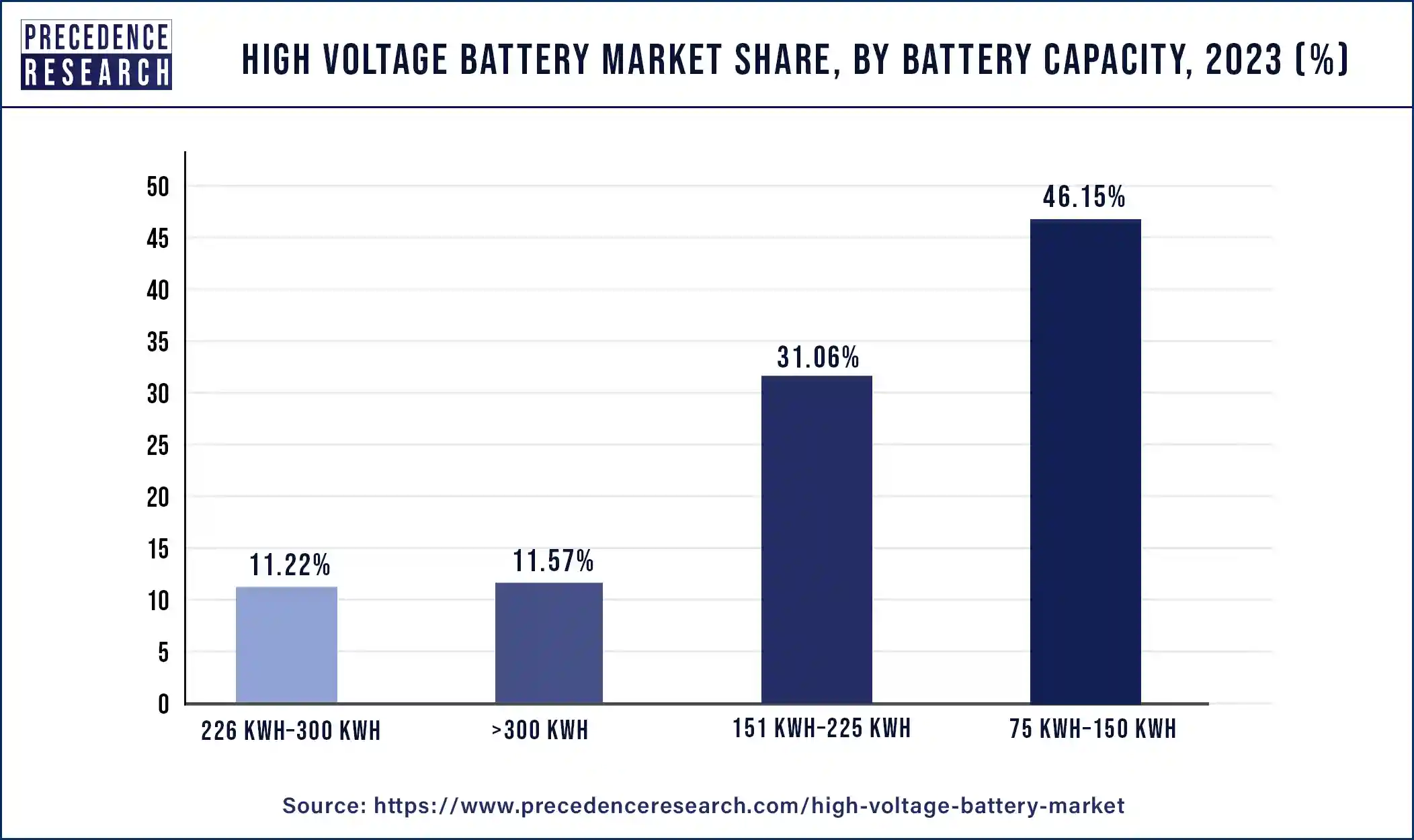
Among the high voltage battery market, the high voltage battery >75kWh battery capacity are used in electric passenger cars, electric trucks, and electric buses. The lithium ion batteries have dominance in the market as the various key market players are at the forefront of developing electric vehicles. Lithium-ion batteries are the mainstream battery cells for electric vehicles but only 3.6V per cell. The modules are connected in the series of 280V,360V, etc. The nickel-metal hydride, lead acid and ultracapacitors are also used in electric vehicle batteries. Among these the Lithium Iron Phosphate battery (LFP) have various applications in cars, bicycles and solar devices. These types of batteries are well suited for the applications which require high-load currents and endurance.
The lithium nickel-cobalt-Aluminum oxide have different applications such as power grid application, medical devices and electric cars. The market leader Tesla deploys NCA batteries in their electric vehicles system. The other NMC batteries can also use in same application like NCA batteries. The use of high voltage batteries is mostly in hybrid and electric industries.
Global High Voltage Battery Market, By Battery Capacity, 2022-2024 (USD Million)
| By Battery Capacity | 2022 | 2023 | 2024 |
| 75 kWh–150 kWh | 8,656.7 | 11,117.1 | 14295.7 |
| 151 kWh–225 kWh | 6,111.6 | 7,482.8 | 9178.4 |
| 226 kWh–300 kWh | 2,260.5 | 2,704.1 | 3238.7 |
| >300 kWh | 2,192.1 | 2,782.4 | 3540.4 |
ApplicationInsights
The high voltage batteries have increasing demand for sectors like high driving range vehicles and in smart transportation which are likely to drive the market in forecast period. The >300kWh batteries is mostly used in electric bus industry especially in China. The applications are mostly found in electric public transports like electric buses and trucks which in turn are expected to drive the high voltage battery market. In the present scenario most of the electric vehicles falls under the range of 251-400 miles and 401-550 miles driving range and are expected to move towards > 500 miles range which will coordinate with the advancement of high voltage battery.
The aerial survey drones use a standard 22.V or 44.4V battery and the energy of high voltage lithium battery increases its flight time under the same user environment. The attributes like high energy density, longer battery life, and high and stable discharge platforms have provided benefit in terms of gaining large scale in the battery market.
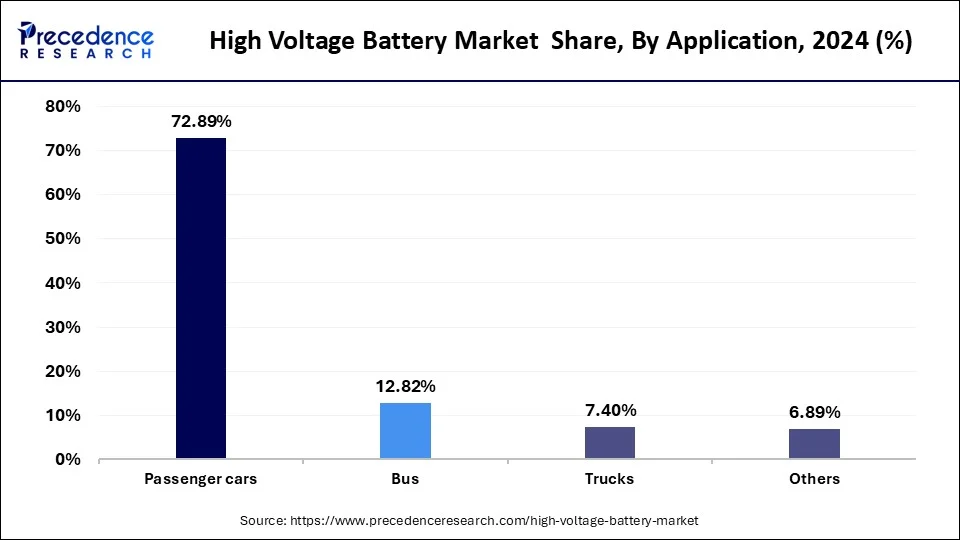
The buses segment is observed to sustain the dominance during the predicted timeframe. The rising adoption of electric buses for public transportation purposes to curb environmental concerns creates a significant potential for the segment to grow. Rapid urbanization has led to increased traffic congestion and air pollution in cities, prompting authorities to seek cleaner and more efficient public transportation solutions. Electric buses offer an environmentally friendly alternative to traditional diesel or gasoline-powered buses, with zero tailpipe emissions and reduced noise pollution.
Global High Voltage Battery Market, By Application, 2022-2024 (USD Million)
| By Application | 2022 | 2023 | 2024 |
| Passenger Cars | 12,573.0 | 16,704.4 | 22,052.8 |
| Bus | 3,059.4 | 3,444.2 | 3,878.7 |
| Trucks | 1,890.8 | 2,057.3 | 2,238.5 |
| Others | 1,697.8 | 1,880.5 | 2,083.2 |
Battery Type Insights
The lithium nickel manganese cobalt oxide segment was observed to have a significant share of the market in 2024. The segment is further expected to maintain its position during the forecast period. The cost-effectiveness offered by lithium nickel manganese cobalt oxide batteries, especially for electric vehicles. This factor promises a sustained rate of adoption of these batteries.
The lithium nickel manganese cobalt oxide batteries offer increased battery storage capacity with layered structure while allowing lithium ions to be stored. Moreover, the initial investment for such batteries is comparatively lower, despite the occurrence of global events of fluctuating prices.
Voltage Insights
The 400-600V segment held a notable share of the high voltage battery market in 2024. The 400-600V voltage range is widely considered optimal for high voltage battery applications in various industries, including electric vehicles (EVs), renewable energy storage systems, and grid stabilization solutions. Batteries operating within this voltage range strike a balance between power output, energy density, and safety considerations, making them suitable for a wide range of applications.
Driving Range Insights
The >550 miles segment is observed to grow at the most significant rate during the forecast period. As consumers become more inclined towards electric vehicles, there is a growing demand for EVs with longer ranges that can meet the needs of daily commuting as well as long-distance travel. The >550 miles segment caters to this demand by offering batteries capable of supporting longer journeys without compromising on performance or convenience.
Regional Insights
Asia Pacific High Voltage Battery Market Size and Growth 2025 to 2034
The Asia Pacific high voltage battery market size is valued at USD22.10 billion in 2025 and is estimated to reach around USD 419.30 billion by 2034, growing at a CAGR of 38.70% from 2025 to 2034.
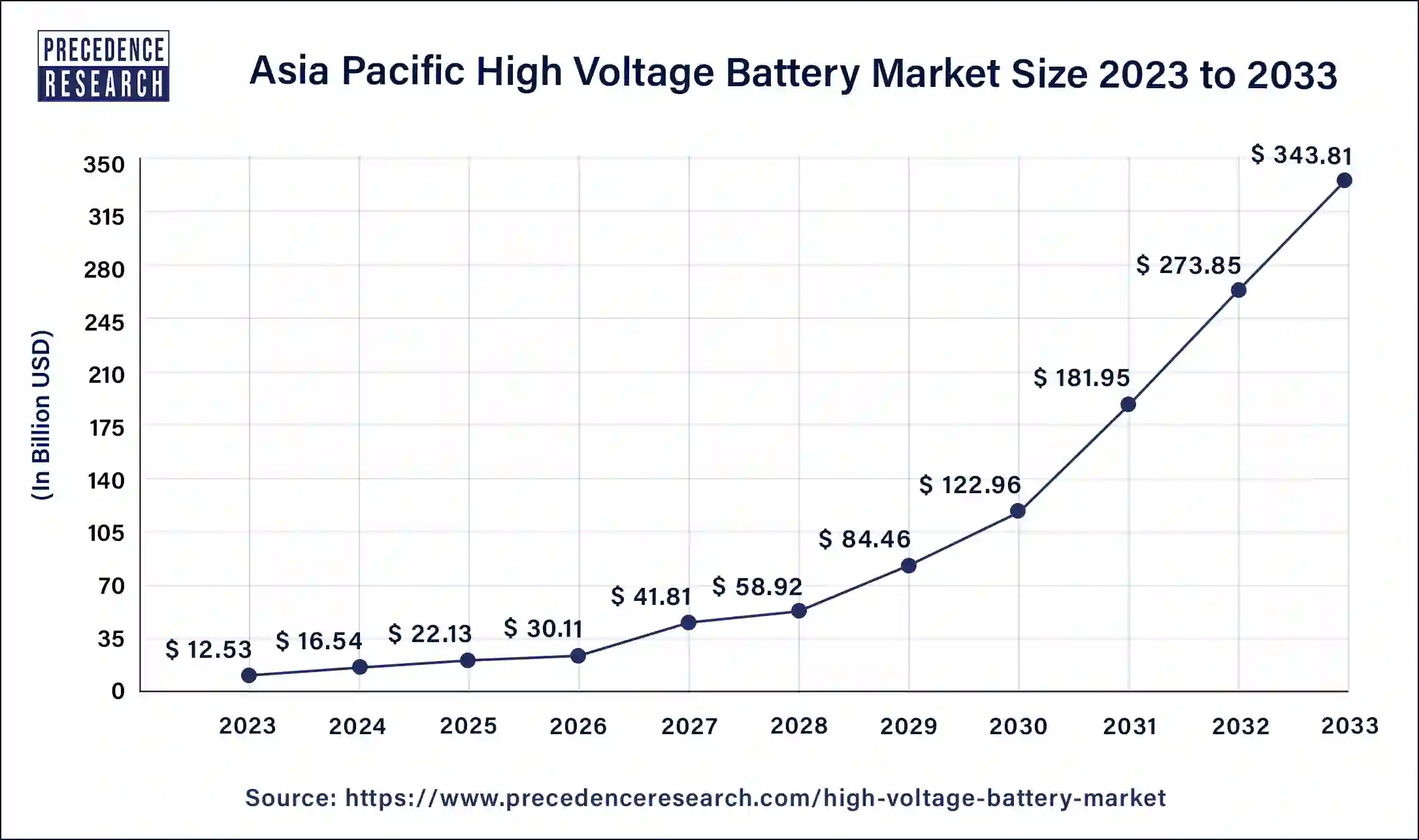
Among the various regions like Asia Pacific, Europe, North America and the RoW. The Asia Pacific is expected to hold the largest market share. Various factors like the domination of Chinese Industry in terms of Electric vehicle sector, strong economic growth, rising focus towards smart cities and favorable government interference have appreciated the demand of high voltage battery in this region. Among the region China accounts for highest market share of about 78.8% in the global high voltage market which are the results of growing electric busses in the country. China and South Korea are also the biggest manufactures of high voltage battery which also highly contribute to the supply chain industry of high voltage battery. Enormous opportunities lie in the country like China where Tesla is planning to produce 500,00 cars in China and many more such developments are expected to help Asia Pacific to gain the largest market share.
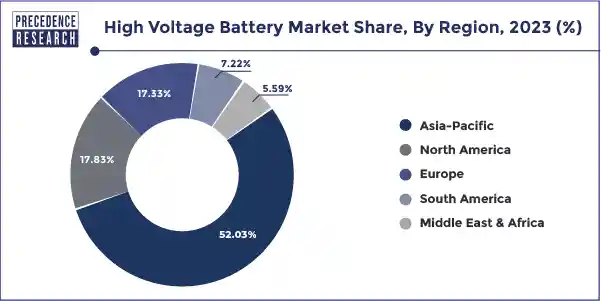
How Europe is Rising the Ladder High Voltage Battery Market?
Europe is quickly emerging as a global leader in the high-voltage battery market, strongly influencing electrified mobility and energy storage solutions. The region's robust regulatory framework, ambitious sustainability goals, and significant investments in technological innovations have propelled its growth in this sector. The European Union has implemented stringent emissions regulations and carbon neutrality targets, driving demand for electric vehicles (EVs) and energy storage solutions. Significant investments in gigafactories and battery production capabilities are being made by both established automakers and new entrants, positioning Europe as a central hub for high-voltage battery manufacturing.
Germany's Industry Trends:
Germany is a leading player in high-voltage battery production, home to major automotive manufacturers like Volkswagen and BMW that are rapidly advancing their EV lineups. The commitment to building large-scale battery production facilities gigafactories aligns with the nation's goals for sustainable transportation and energy transition. Germany is investing heavily in research and development for advanced battery technologies, such as solid-state batteries.
Market Value Chain Analysis
- Raw Material Sourcing: Carbonate and hydroxide feedstocks for high-energy chemistries; demand sensitivity to EV scale-up. used in high-energy NMC/NCA cathodes; cobalt reduction strategies are increasingly important to limit social-risk exposure. natural and synthetic graphite for anodes; silicon blending is rising to increase energy density. enabling lower-cost or lower-criticality chemistries LMR, LFP alternatives. Procuring battery-grade materials requires high-purity refining, stable long-term contracts, and traceability systems to meet regulatory and ESG expectations.
- Technological Advancements: Cell chemistry evolution: higher-nickel cathodes for energy density, LFP for cost and safety trade-offs, and ongoing R&D on solid-state and semi-solid electrolytes. silicon-composite anodes and advanced binders to increase capacity without compromising cycle life. electrolyte additives and thermal systems that accommodate high C-rate charging.
High Voltage Battery Market Companies
- Tesla: A US-based company that manufactures both electric vehicles and battery systems.
- BYD: A Chinese company that produces both new energy vehicles and their batteries.
- LG Chem: A South Korean company with a strong presence in battery production.
- Samsung SDI: A South Korean company that manufactures batteries for a variety of applications.
- CATL: A Chinese company that has become the world's largest battery manufacturer.
Recent Developments
- In May 2019, an agreement has been signed by American Battery solution, Inc in order to acquire manufacturing and testing assets for high voltage battery systems from Robert Bosch Battery system.
- In May 2018, there was an introduction of new high- power charging options in by Poterra to achieve 100% electric bus fleet at the American Public Transportation Association's (APTA) Bus and Paratransit Conference. The system is more reliable, having smarter charging which is flexible, scalable and powerful.
Segments covered in the Report
By Battery Capacity
- 75 kWh–150 kWh
- 151 kWh–225 kWh
- 226 kWh–300 kWh
- >300 kWh
By Battery Type
- Lithium Iron Phosphate
- Lithium Nickel Manganese Cobalt Oxide
- Lithium Nickel Cobalt Aluminium Oxide
- Others
By Voltage
- 400–600V
- >600V
By Driving Range
- 100–250 miles
- 251–400 miles
- 401–550 miles
- >550 miles
By Applications
- Passenger cars
- Bus
- Trucks
- Others
By Geography
- North America
- Europe
- Asia-Pacific
- Latin America
- Middle East & Africa (MEA)
For inquiries regarding discounts, bulk purchases, or customization requests, please contact us at sales@precedenceresearch.com
Frequently Asked Questions
Ask For Sample
No cookie-cutter, only authentic analysis – take the 1st step to become a Precedence Research client